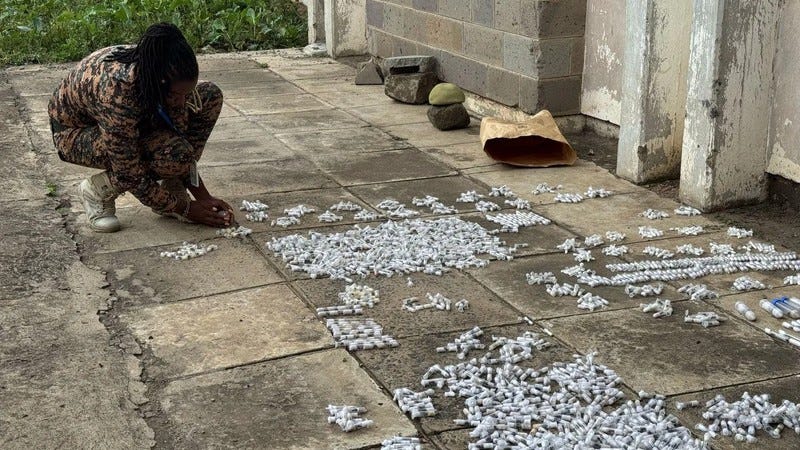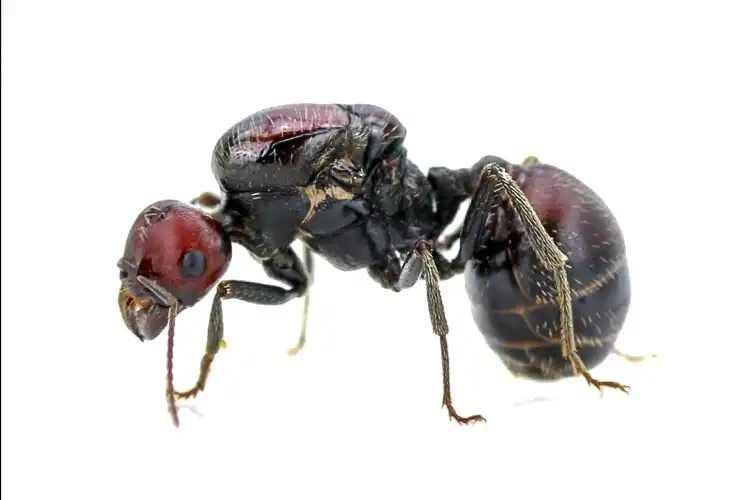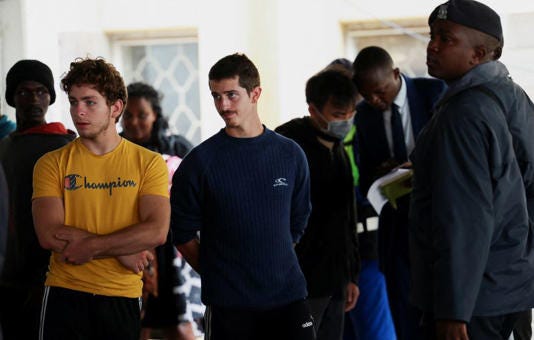A bugs life in the illegal trade
The Kenyan case drawing attention to those creatures great but small.
After this week’s Wild Crime Report, I received some follow up questions on the peculiar case of the trafficked ants that unfolded in Kenya this month. And fair enough too as it was something that sounded more like a plot twist from a quirky crime novel than a real-world wildlife scandal.
The case, or indeed cases to be precise, involved four individuals—two Belgian teenagers, a Kenyan, and a Vietnamese national—who all stood in a Nairobi courtroom and pled guilty to trafficking over a combined number of 5,400 live ants. The ants were identified as the Giant African Harvester Ant (Messor cephalotes), and were valued by prosecutors at USD$7,700. I’ve been skeptical of police and prosecutor led valuations in wildlife cases in the past but in this matter I have limited data or experience to develop an educated opinion regarding the accuracy of that price. But given the defendants went to the trouble of ingeniously bottling these thousands of ants into 2,244 test tubes and syringes to evade detection, you’d have to assume the tiny creatures carried some degree of value to warrant such an effort.
The Kenya Wildlife Service (KWS) have hailed this as a landmark bust. But beneath the headlines, I’m curious about a possible deeper story. Is there a rise in ant trafficking that could be a new frontier in wildlife crime?
This isn’t Kenya’s first brush with ant smuggling. In 2023, three suspects were nabbed at Jomo Kenyatta International Airport with 56 syringes of ants disguised as handicrafts, destined for France. As the recent case has highlighted, it’s small in scale compared to larger seizures of elephant ivory or rhino horn that usually dominates wildlife crime deadlines. And as the prosecutors appear to be agitating in this latest case, it’s not size that matters but rather a show of force by Kenya that it is serious about protecting biodiversity.
But back to the key question. Why ants and why now?
At first glance, ants seem an unlikely target for wildlife criminals. They’re not majestic like elephants or rare like pangolins. There doesn’t appear to be a demand from major wildlife markets in Asia which is traditionally the culprit for driving such trades.
However, like many exotic species, the market is not driven by broad consumer demand but instead through a niche group of collectors, often in Europe, Asia or North America. The BBC reported that UK ant dealers could spend up to USD$220 for Giant African Harvester ants. Amongst their sources was the online trading hub Best Ants UK where you can find a great number of ants from around the world. Amongst their selection of harvester ants, the striking red-black African Giant Harvester ant is indeed listing queen ants for £169.99 but as of writing are ‘out of stock’.
The police valuation of $7,700 may not be far off the mark after all.
Online platforms where ants are prized for artificial ant farms, known as formicariums, are presumably a refuge for enthusiasts fascinated by the striking range of species provided and no doubt the intricate colony building behavior. But with single queen ants advertised at such premium prices, it is a legitimate passion that is a target for would be traffickers fueling a black market where prices can easily soar.
And the demand isn’t unique to ants. The illegal trade in insects has shown the potential for profits driven by the same collectors’ zeal for rare and exotic species. Four years ago, a Japanese national was sentenced to two years imprisonment in Ecuador after attempting to smuggle a suitcase load of spiders, butterflies, wasps and beetles.
Protected butterflies are also the target for collectors. Last year in Sri Lanka, two Italian nationals were fined a whopping USD$200,000 for attempting to collect and smuggle hundreds of insects which included 92 species of rare butterflies. Another butterfly case occurred 3 years earlier in Thailand where a chef was caught attempting to sell eight preserved butterflies.
And also in the United Kingdom, where a collector with over 4,000 species at his home was charged in relation to illegally trading protected butterflies online that were believed to have come from China, Vietnam and Costa Rica.
Butterflies, like rare beetles, are prized for their iridescent colors and dramatic features. Prices on the retail market can vary from less than a hundred to a few thousand dollars to even, if the price is to be believed, over $10,000 for a rare butterfly such as the Queen Alexandra’s Birdwing.
Like ants, beetles and butterflies are small, easy to conceal, and require minimal equipment to collect—often just nets or vials. They’re smuggled in similar ways to other illegal wildlife commodities: tucked into luggage, misdeclared as curios, or disguised in modified containers like the test tubes used in Kenya.
And with plenty of legal markets in certain species in physical pet shops and amplified through social media and e-commerce platforms, traffickers have plenty of opportunity to launder the illegally sought products through legal supply chains. And with products reaching prices in the thousands, and the means of smuggling being so rudimentary and fairly cheap to implement, the trade becomes an attractive target for more sophisticated transnational criminal networks. Especially those crime networks already dealing in other exotics such as reptiles, birds or plants.
Socioeconomic factors will also ultimately drive persistence in the countries where bugs are sourced. In a country like Kenya, where poverty can fuel illegal trade, insect collection offers poachers quick cash with less risk than hunting elephants. A local poacher might earn more from a vial of ants or beetles than from an average month’s labor, with less fear of severe penalties. This dynamic, which is already seen across other illegal wildlife trades globally, suggests the same community led solutions to address root causes of poverty and education about ecological value of endemic species, must be installed alongside enforcement efforts.
Because an unchecked uptick in the insect trade will become a conservation concern.
Ants disperse seeds and aerate soil, beetles decompose organic matter, and butterflies pollinate plants. Their removal disrupts ecosystems, especially when entire populations, like ant queens, are harvested.
Kenya, where this latest case has unfolded, naturally has its own diverse habitats where ants are critical to the eco-structure. The country has at least 596 different ant species. Areas such as the Kakamega Forest and coastal woodlands are home to these unique ants alongside rare beetles and butterflies. The guesthouse where the two Belgian nationals, David Lornoy and Seppe Lodewijckx, were found in possession of 5,000 ants was in proximity to the wildlife rich Hell’s Gate National Park.
Ant trafficking, like the broader insect trade, poses real challenges for law enforcement. Unlike ivory or tiger skins, insects don’t trigger red flags at customs. Local legislation, such as Kenya’s Wildlife Conservation and Management Act may be enacted to protect insects but I can’t imagine that most officers are trained to spot ant, beetle, or butterfly smuggling.
While international frameworks like CITES do list some butterflies and beetles on the appendices to assist with regulation, ants do not share that same honor. Meaning that the gap allows traffickers to exploit loopholes through misdeclaring species or even funneling them through less enforced transit countries.
And of course, public perception compounds the problem. Insects don’t inspire the same emotional outcry as poached rhinos although the KWS press team have done a good job of elevating the exposure of this latest ant matter. But public pressure and exposure matters. It matters for awareness, political leverage, increased education and training and the allocation of resources for investigators to work hand in hand with conservationists.
The Kenya ant case, alongside other niche insect cases, is a stark reminder that environmental crime doesn’t always look like a bloodied elephant or a chainsawed rainforest. In fact, it’s precisely the sort of low risk-high reward, under the radar type of crime that can exploit the blind spots of wildlife protectionists. A niche trade with a clandestine nature - small packages and deals between a tight circle of collectors - making it very hard to track.
It should serve as a wake up call to all of us who cherish the environment and see the importance of enforcement. If we want to safeguard species and protect eco-systems then our efforts and attention shouldn’t be reserved solely for those big and beautiful creatures. The dual objective of preserving biodiversity and curbing the trafficking of species should also be fought for those as ubiquitous as an ant or as delicate as a butterfly.
Especially when there is a propensity for it to be scaled up and royally bug-ger things up.








